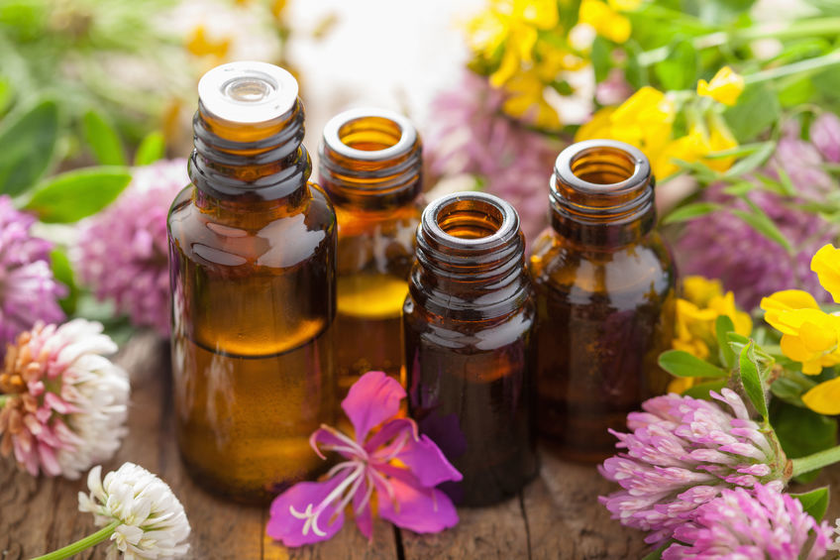
Essential oils possess nature’s most luxurious body and home care ingredients! Luckily, they are also easy to use. After all, who has the time to fuss these days? But with just a little bit of effort, you can feel as clever as Martha Stewart herself when all your cleaning and body care products smell great and are earth-friendly, too. Essential oils are practical and inexpensive but feel frivolous! We think that is “a good thing.” 🙂
Many essential oils have been used for centuries and are included in ancient healing traditions worldwide. Even Hippocrates, the father of medicine, said: “The way to health is to have an aromatic bath and scented massage every day.”
Wake up your inner Earth Mama and transform what you’re putting on your body and breathing in at your home. You can feel good about using essential oils. When properly used, they are safe for everyone, especially young kids and their developing immune systems. We hope you enjoy our beginner’s guide!
Ways to Use Essential Oils
Essential oils are distilled from plants, shrubs, flowers, trees, roots and seeds. They come from every corner of the Earth. Chemists have identified over 70,000 different chemical compounds in essential oils, each having a therapeutic use. Here are just a few ways they can be used in your home:
- Cooking: Add to drinks, meals, and desserts (Note: ONLY use essential oils meant for consumption. Attend our May event for specific tips on using essential oils for cooking.)
- Personal body care: Mix with salts, soaps, or bath bombs, homemade toothpaste
- Cleaning: Use for hand soaps, sanitizers, carpet deodorizers
- Laundry: Add to laundry soaps or use with wool dryer balls
- Insect repellant: Effective for pests like mosquitoes, ants, spiders, cockroaches
- Medicinal care: Use on bug bites, skin rashes, toothaches and as a sleep aid
- Aromatherapy: Select your favorites to circulate throughout the house with a diffuser or just for your personal enjoyment with a simple cotton ball. Essential oils can be energizing, calming, cleansing, relaxing . . . there’s one to suit your mood!
 To learn even more about essential oils, attend our next event, Essential Oils: Safe & Savvy Secrets. Our own Tillie Alenikoff, Registered Aromatherapist, will show you how to safely and effectively use oils for personal and home care. She’ll also show you which oils to avoid during pregnancy, for certain medical conditions and for pets (the lists for dogs and cats are different!) You’ll be entered into a raffle and will take home quick-reference guides. Bring all your questions! EVENT HAS ALREADY TAKEN PLACE.
To learn even more about essential oils, attend our next event, Essential Oils: Safe & Savvy Secrets. Our own Tillie Alenikoff, Registered Aromatherapist, will show you how to safely and effectively use oils for personal and home care. She’ll also show you which oils to avoid during pregnancy, for certain medical conditions and for pets (the lists for dogs and cats are different!) You’ll be entered into a raffle and will take home quick-reference guides. Bring all your questions! EVENT HAS ALREADY TAKEN PLACE.
How to Select Quality Essential Oils
It’s worth noting that the FDA only requires an oil to contain 10% essential oils to be labeled “100% pure.” Therefore, finding a reputable company is important. The best essential oils are sourced carefully and sustainably from around the world and are tested for purity and quality.
Companies that take pride in their products will usually provide gas chromatography (GC) or mass spectroscopy (MS) test results. You can request copies of this testing to verify the quality of their oils, including a breakdown of their chemical properties, the geographic breakdown, harvest time of the year, even if their herbs were blooming at the time.
Most quality companies will present you with the following information about their oils:
- Common name (i.e. Thyme)
- Scientific name (i.e. Thymus Vulgaris)
- How is it extracted (i.e. steam distillation) – Some lower-quality companies may use chemicals to extract oils…which defeats our intention to find healthy alternatives to the chemicals found in conventional products!
- Part of the plant used (i.e. flowering tops) – Depending on your intended therapeutic purpose for the oil, it may be important to be this specific.
- Country of origin (i.e. France)
- Lot number (generally corresponding with GC or MS test)
- Quantity (amount in bottle)
- Company contact information
Probably the simplest and most important quality marker for the average consumer to recognize is the phrase, “Therapeutic Grade!”
You want to buy therapeutic grade essential oils to ensure they contain the constituents (chemical compounds) that provide the therapeutic properties you seek. For example, a lower-quality lavender oil may help you sleep but may not effectively address skin conditions. Low-quality oils may not have the same therapeutic effects due to the difference in chemical constituents found only in pure, therapeutic grade oils.
Resources for general descriptions of testing types (if you like to geek-out over details):
https://tisserandinstitute.org/highs-lows-gc-ms-essential-oil-analysis/
https://artisanaromatics.com/msds-essential-oil-safety/
https://artisanaromatics.com/essential-oil-gc-ms/
Things to Know When Using Essential Oils
There are just a few basics before you begin!
How to store your essential oils:
Store your essential oils in glass, amber-colored bottles that close tightly. Put them in a cool, dark location (refrigeration is ideal). Keep out of reach of children!
Essential oils safety tips:
Most essential oils need to be diluted for use on the skin. Some can be “phototoxic” which means they can cause a reaction if the skin is exposed to sunlight. Check labels, but generally oils that are known to cause photosensitivity are: angelica root, bergamot, cumin, melissa, and most citrus essential oils (grapefruit, lemon, lime, orange).
Carrier oils:
Essential oils are diluted with what we call “carrier” oils. Just like essential oils, opt for high-quality carrier oils that are unrefined and have been naturally extracted and cold-pressed. Common carrier oils are: almond or sweet almond, apricot kernel, cocoa butter, coconut, jojoba, kukui nut, olive and shea butter. Some of these oils have healing properties of their own!
Skin-patch test:
If you have any allergies or sensitive skin, perform a skin-patch test prior to using essential oils.
- Apply 1-2 drops of essential oil to the forearm.
- Observe for 1-2 hours.
- Usually reactions occur within 5-10 minutes.
- Avoid use of the oil if any redness, swelling, or blistering occurs.
General essential oils safety:
If a dangerous quantity of EO has been ingested, contact Poison Control immediately! (800-222-1222)
Be prepared to provide the brand and type of oil. Poison Control is aware of different essential oil brands and can give better advice when you can provide the specific brand name.
If you are unable to contact Poison Control, drink olive oil and induce vomiting. The olive oil will slow down the absorption and dilute the essential oil. Do not drink water as this can increase absorption.
Never use water to flush an oil off the skin, as this may increase discomfort. If an essential oil gets in your eye, flush with a carrier oil to alleviate discomfort. If discomfort does not subside within five minutes, seek medical attention.
General health warnings:
If you are pregnant, lactating, suffering from epilepsy or high blood pressure, have cancer, liver damage or other medical conditions, use essential oils under the supervision of a medical doctor or qualified aromatherapist. If taking prescription medications, check for interactions between your medicine and the essential oils you want to use.
 To learn even more about essential oils, attend our next event, Essential Oils: Safe & Savvy Secrets. Our own Tillie Alenikoff, Registered Aromatherapist, will show you how to safely and effectively use oils for personal and home care. She’ll also show you which oils to avoid during pregnancy, for certain medical conditions and for pets (the lists for dogs and cats are different!) You’ll be entered into a raffle and will take home quick-reference guides. Bring all your questions! EVENT HAS ALREADY TAKEN PLACE.
To learn even more about essential oils, attend our next event, Essential Oils: Safe & Savvy Secrets. Our own Tillie Alenikoff, Registered Aromatherapist, will show you how to safely and effectively use oils for personal and home care. She’ll also show you which oils to avoid during pregnancy, for certain medical conditions and for pets (the lists for dogs and cats are different!) You’ll be entered into a raffle and will take home quick-reference guides. Bring all your questions! EVENT HAS ALREADY TAKEN PLACE.
The 8 Best Essential Oils to Have on Hand
It doesn’t take long to gather your own essential oil collection for personal and home use. Here are some of the most popular oils and a few of their common uses.
Lavender Essential Oil Benefits:
Known for its ability to promote tissue regeneration, lavender is often used for burns. Lavender is gentle and is one of very few oils that can be used full-strength on the skin (adults only—dilute in a carrier oil for babies and children).
Uses:
- Mental / Emotional: calming, relaxing, for depression and insomnia
- Muscular / Joint: headaches, cramps, inflammation of muscles and joints
- Respiratory: bronchitis, colds, asthma and whooping cough
- Skin: skin conditions such as acne, eczema, burns and scars, wounds, ulcers, insect repellant and insect bites
Peppermint Essential Oil Benefits:
Peppermint has a strong, clean, fresh, minty aroma. It has long been highly regarded for digestion. It has also been studied for its supportive effect on the liver and respiratory systems, ability to improve concentration and mental sharpness, and its direct effects on the brain’s satiety center, which triggers a sensation of fullness after meals. When using topically for children, remember to dilute your essential oil in at least a 50/50 mixture.
Uses:
- Add a drop of peppermint essential oil to herbal tea to help aid normal digestion (1 drop to 1 gallon).
- Massage several diluted drops of peppermint essential oil on the abdomen, place a drop on wrists, or inhale to soothe minor stomach discomfort.
- Rub one drop of diluted peppermint essential oil on the temples, forehead, over the sinuses (careful to avoid contact with your eyes), and on the back of the neck to relieve head pressure.
- Place 1 drop of peppermint essential oil on the tongue and rub another drop of oil under the nose to help improve concentration and alertness.
- Diffuse or inhale peppermint essential oil mid-morning to curb the desire to snack.
- Rub 1 drop of peppermint directly to an insect bite to lessen itching associated with histamine response.
Tea Tree Essential Oil Benefits:
Tea tree oil is a naturally antifungal, antibiotic and antibacterial substance. Two to four drops can safely be applied directly to the desired area. Dilution is not required, except for the most sensitive skin and for children.
Uses:
- Mental / Emotional: mental clarity, stress, trauma and shock
- Muscular: muscle aches and pains
- Respiratory: congestion and respiratory infections, cough, sinusitis, whooping cough and TB
- Skin / Hair: acne, athlete’s foot, nail fungus, blisters, burns, cold sores, insect bites, rashes, warts, wounds, dandruff and lice
- Urinary / Genital: thrush, vaginitis and cystitis
Eucalyptus Essential Oil Benefits:
Eucalyptus radiata is cooling, refreshing, and energizing. Lighter in smell than Eucalyptus globulus, it has many of the same supportive properties. Because it is relatively gentle and nonirritating, it is the preferred choice for children. This variety is one of the most versatile of the eucalyptus oils and is suitable for topical use, diffusing, and even direct inhalation. Known as one of the best remedies for the respiratory system, it is antiseptic, expectorant and antispasmodic.
Uses:
- For topical use, dilute in a 50/50 mixture and apply to chest 3-4 times daily.
- As an aromatic, diffuse up to 30 minutes three times daily.
- Add a few drops to a steaming bowl of water. The heat will vaporize the essential oil, and you can inhale the moist, aromatic air to support your breathing. It may also dry up phlegm and provide relief of sinusitis.
Clove Essential Oil Benefits:
The most prominent use of clove oil is in dental care. The germicidal properties of the oil make it very effective for relieving dental pain, toothache, sore gums and mouth ulcers. But don’t try to use it straight on a baby’s gums for teething (as is often suggested), or you may end up with a screaming baby! Clove oil tastes strong and hot! Dilute to at least a 50/50 mixture with coconut oil.
Uses:
- Circulatory: inhibits blood clot formation, increases blood flow
- Digestive: gas, dysentery, diarrhea
- Immune: antibacterial, antiviral.
- Muscular / Joints: arthritis
- Respiratory: decongestant, bronchitis
- Skin: insect bites, acne, dermatitis, warts
Lemon Essential Oil Benefits:
Lemon oil has a strong, purifying, citrus scent that is revitalizing and uplifting. Avoid using on infants and very small children. Avoid using on skin exposed to direct sunlight or UV rays.
Uses:
- Use 1–2 drops of lemon essential oil to remove gum, oil, grease spots, glue or adhesive, and crayon from most surfaces.
- Combine 2–3 drops of lemon essential oil with water in a spray bottle to help cleanse and sanitize surfaces.
- Place a drop of lemon essential oil on oily skin or blemishes to help balance oil glands and minimize oil production.
- Soothe corns, calluses, or bunions by rubbing lemon essential oil on the affected area morning and evening.
- Massage lemon essential oil into cellulite to help improve circulation and eliminate waste from cells.
- Inhale lemon essential oil or place a few drops on a cotton ball to replenish your mind, body and spirit.
- Add 10–15 drops of lemon essential oil to a gallon of carpet cleaning solution to help pull out stains, brighten carpet and rugs and leave a fresh smell in the room.
- Place a few drops of your favorite citrus essential oil on a cotton ball and put in the refrigerator to help eliminate odors.
Oregano Essential Oil Benefits:
Oregano has become one of the most well-known essential oils due to its strong antiviral benefits. It contains strong immune-enhancing and antioxidant properties and supports the respiratory system.
Uses:
- Digestive: Traditionally used for diarrhea, vomiting and upset stomachs. Can eliminate intestinal worms and other parasites.
- Muscular / Joints: Eases headaches, rheumatism, arthritis and general aches and pains.
- Respiratory: Used for asthma, bronchitis, coughs, colds, fever, sore throats, flu and viral infections.
- Immune: Boost immune system, fights all types of bacterial infections without inhibiting your internal “good bacteria”.
- Skin: Can soothe itchy skin conditions, stings, bites, wounds, inflammation and fungal infections.
Frankincense Essential Oil Benefits:
Frankincense comes from a tree resin and, as we know from the Bible reference, has been used for thousands of years! Its medicinal properties include: antiseptic, astringent, diuretic, expectorant, sedative, anti-inflammatory, antidepressant and immune stimulant.
Uses:
- Add frankincense to your moisturizer to highlight your natural beauty and promote the appearance of healthy-looking skin and even skin tones.
- Invite elevated spiritual experiences every day by diffusing this oil in your home.
- Incorporate frankincense into your yoga ritual by diffusing it during your routine to promote feelings of relaxation and tranquility.
Easy Body Care and Aromatherapy Recipes with Essential Oils
In order to make body care and cleaning supplies, you’ll need some everyday items such as: lemons, white vinegar, unscented liquid Castile soap, Epsom salts, baking soda, sea salt, vegetable glycerin, and an assortment of amber-colored glass jars, spray bottles and dropper bottles. The dark colors keep light from degrading the oils and glass is your best non-reactive choice for storage. The internet is full of recipes, but here are two to get you started!
Lavender Body Butter
Ingredients:
- ¼ cup cocoa butter
- 3 tablespoons sweet almond oil
- 1 teaspoon vegetable glycerin
- 50 drops lavender essential oil
Directions:
- In a sauce pan over low heat, melt cocoa butter.
- Remove from heat and stir in sweet almond oil, vegetable glycerin and lavender essential oil.
- Transfer mixture to a mixing bowl set in an ice water bath. Whip mixture as it sets up into a cream.
- Remove cream from ice water bath and scoop into a jar. Apply desired amount to skin.
Lavender and Grapefruit Diffusion Salts
Ingredients:
- ½ cup medium to coarse grain sea salt
- 24 drops lavender essential oil
- 24 drops grapefruit essential oil
- 4-ounce wide amber glass mouth jar
Directions:
- Measure salt and essential oils into jar, replace lid and shake until well mixed.
- To use, remove lid and allow desired amount to diffuse.
- Replenish with additional essential oils whenever scent begins to fade.
 To learn even more about essential oils, attend our next event, Essential Oils: Safe & Savvy Secrets. Our own Tillie Alenikoff, Registered Aromatherapist, will show you how to safely and effectively use oils for personal and home care. She’ll also show you which oils to avoid during pregnancy, for certain medical conditions and for pets (the lists for dogs and cats are different!) You’ll be entered into a raffle and will take home quick-reference guides. Bring all your questions! EVENT HAS ALREADY TAKEN PLACE.
To learn even more about essential oils, attend our next event, Essential Oils: Safe & Savvy Secrets. Our own Tillie Alenikoff, Registered Aromatherapist, will show you how to safely and effectively use oils for personal and home care. She’ll also show you which oils to avoid during pregnancy, for certain medical conditions and for pets (the lists for dogs and cats are different!) You’ll be entered into a raffle and will take home quick-reference guides. Bring all your questions! EVENT HAS ALREADY TAKEN PLACE.
Image copyright: 123rf.com/duskbabe





